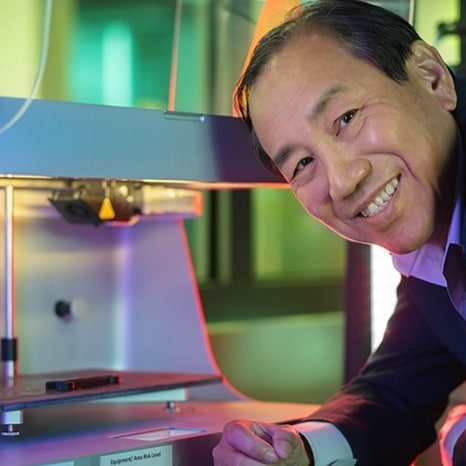3D Printing Steps up to the Frontlines in the Battle Against Covid-19
SUTD - Hong Wei Tan, Hong Yee Low, Chee Kai Chua
NTU - Yu Ying Clarrisa Choong, Wan Ting Natalie Choong, Chun-Hsien Chen, Ming Jen Tan
Cedars-Sinai Medical Center - Deven C. Patel
HP Inc- Chandrakant D. Patel
 Corresponding author, Professor Chua Chee Kai at one of 3D printing facilities in SUTD.
Corresponding author, Professor Chua Chee Kai at one of 3D printing facilities in SUTD.
The versatility of 3D printing has enabled on demand solutions for needs ranging from personal protection equipment to medical devices and isolation wards, proving the technology’s vital use in addressing worldwide disruptions in supply chains.
The prevalence of the highly infectious coronavirus disease, COVID-19, has caused massive health and socio-economic upheavals worldwide. Major slumps in industrial production due to stringent lockdown measures and export restrictions have led to severe logistical challenges and drastic disruptions to the global supply chains. Rising to the challenges and unprecedented demands, the 3D printing technology has demonstrated operational resilience with timely and innovative responses to help in the global supply efforts.
In an article published in Nature Reviews Materials, researchers from the Singapore University of Technology and Design (SUTD), Nanyang Technological University, Cedars-Sinai Medical Center and HP Inc examined how the digital versatility and quick prototyping of 3D printing has enabled the swift mobilisation of the technology and a rapid response to emergencies in a closed loop economy.
The researchers explained how 3D printing has enabled product customisation, complex designs and on-demand manufacturing using any decentralised 3D printing facility in the world by leveraging designs shared online. This has led to the broad spectrum of 3D printing applications in the fight against COVID-19 including the printing of personal protective equipment (PPE), medical and testing devices, personal accessories, visualisation aids, and emergency dwellings.
For instance, due to severe shortages of ventilator machines, continuous positive airways pressure (CPAP) machines were used as substitutes for COVID-19 patients who require sub-intensive therapy. A 3D printable mask connector design, the Charlotte valve, was produced and it was specially designed to fit and connect Decathlon’s Easybreath snorkelling masks to CPAP machines.
3D printing also served as an alternative and more efficient manufacturing option to keep up with the demand for nasopharyngeal (NP) swabs. The 3D printed NP swabs were fabricated with complex tip structures for enhanced sample collection efficacy, hence eliminating the need to apply flocks at the tips. Separately, 3D printing has even been used to fabricate temporary emergency dwellings to isolate those under quarantine, relieving the overloaded medical infrastructures.
The article additionally discussed technological suitability, accountability of new approved designs, copyright infringements as well as regulations and guidelines that 3D print manufacturers need to abide by to ensure safe and effective performance of 3D-printed medical devices and translate the good intentions of individuals into meaningful contributions.
“The agility and precision of 3D printing has allowed for innovative solutions amidst the supply chain pressures that we are facing globally. This has resulted in rapidly deployable built environment, healthcare medical devices and training tools which have been crucial in the fight to save lives and contain this virus,” said corresponding author Professor Chua Chee Kai from SUTD.
Reference:
The global rise of 3D printing during the COVID-19 pandemic, Nature Reviews Materials. (DOI: 10.1038/s41578-020-00234-3)
Acknowledgements:
This research is conducted in collaboration with HP Inc. and supported by National Research Foundation (NRF) Singapore and the Singapore Government through the Industry Alignment Fund, Industry Collaboration Projects Grant (I1801E0028). This work is also supported by the Cheng Tsang Man chair professorship at Singapore University of Technology and Design (SUTD). The authors acknowledge HP-NTU Digital Manufacturing Corporate Lab and Digital Manufacturing and Design Centre (DManD). The authors thank AuMed, Creatz3D, CIIRC CTU, EnvisionTEC, Isinnova, WASP and Yingchuang Building Technique (Shanghai) Co., Ltd. (WinSun) for the graphical images.